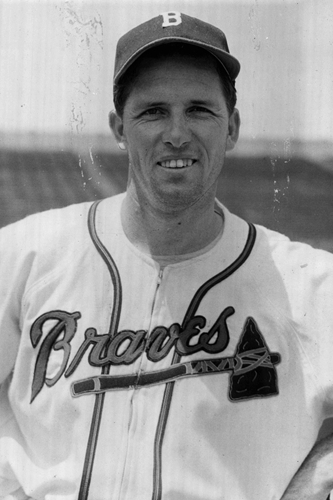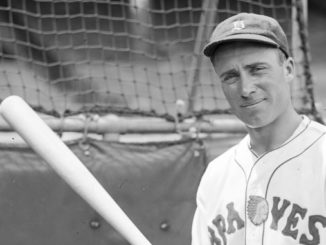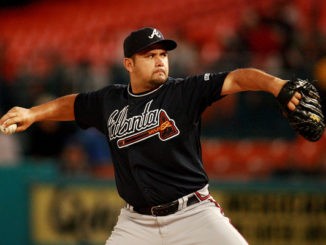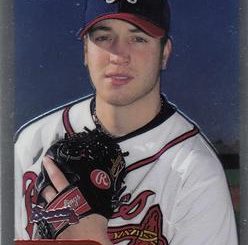The only Brave to wear the number 96: Boston Braves pitcher Bill Voiselle.
Bill Voiselle, born in 1919, played in the majors from 1942-1950. Such absurdly high numbers were unusual at the time, so how did he wind up wearing 96? It was a nod to his hometown of Ninety Six, South Carolina. Remarkably, the town and its less than 2,000 residents don’t really know where the name Ninety Six comes from. Voiselle was proud of his background, so he wore 96. He actually had to get special permission from the NL to wear the number, at the time the highest in MLB history.
Voiselle started out with the NY Giants (who assigned him #17), getting some cups of coffee in ’42 and ’43 before taking the league by storm in his 1944 rookie season. In 1944, the 25 year old went 21-16 with a 3.02 ERA, and led the league in innings (312.2), games started (41), and strikeouts (161). He was an All-Star, finished 5th in the MVP race, and likely would have been named NL Rookie of the Year, had such an award existed at the time. The same might go for the Cy Young Award, as the Sporting News named Voiselle their top pitcher of ’44. More impressively, he won those 21 games for a team that went 67-87. Voiselle remains the last MLB rookie to throw 300 innings in a season.
In 1945, Voiselle endured a sophomore slump, going 14-14, allowing the most earned runs in the NL (4.49 ERA). The following year, he was better at avoiding runs (3.74), but the record continued to plummet, as he went 9-15. In 1947, Voiselle started 1-4, 4.64, before the Giants gave up on their former phenom and traded him to the Boston Braves mid-season for Mort Cooper. Cooper was a former MVP who was the ace of the early-40’s Cardinals, but by ’47 was mid-thirties and obviously in decline. He would post a 7.12 ERA with the Giants that year, briefly exit the game, and return in 1949 to appear in one game, where he allowed 3 runs without registering an out.
Getting away from New York (and Giants manager Mel Ott) may have been good for Voiselle, who went 8-7 for Boston over the remainder of the season, now donning #96 on his back. Now nicknamed “Ol’ Ninety-Six” by the media, Voiselle went 13-13 with a 3.63 ERA for the 1948 National League Champion Braves. In Game 3 of the 1948 World Series against Cleveland, after starter Vern Bickford struggled with his control, walking 5 batters and allowing 2 runs in the first 3.1 innings, manager Billy Southworth called on Voiselle to relieve him. Ol’ Ninety-Six was brilliant, allowing just one baserunner in 3 2/3 innings in his World Series debut. When the series reached Game 6, with the Braves’ backs against the wall, Voiselle got the start. He allowed a respectable 3 runs over 7 innings, essentially matching his counterpart, future HOF-er Bob Lemon (7.1 IP, 3 runs). He was relieved by Braves ace Warren Spahn. Spahn had started and lost Game 2 on Thursday, and he had come into Game 5 on Sunday. Game 6 was Monday, and a likely exhausted Spahn gave up a run in the 8th, a run that would ultimately win the series for the Indians.
He returned to Boston for the 1949 season, where he went 7-8 with a 4.04 ERA. After the season, the somewhat pitching-rich Braves dealt Voiselle to the Cubs for light-hitting infielder and future MLB manager Gene Mauch. Voiselle struggled mightily with the Cubs and was sent to the minor leagues, never to return to the bigs. He bounced around the minors for several years, never giving up the dream, even setting the MiLB single season record (at the time) for games pitched – 72 appearances in 1955 at age 36. After his pro days were done, he returned to Ninety Six, pitched some semi-pro ball there, and lived out the rest of his days. In 2001, the South Carolina House of Representatives honored him, and in 2005, Voiselle passed away at the age of 86.
With a combined b/fWAR of 5.1 in his Braves career, Ol’ Ninety-Six himself is the greatest (and only) Brave to wear #96.





Leave a Reply